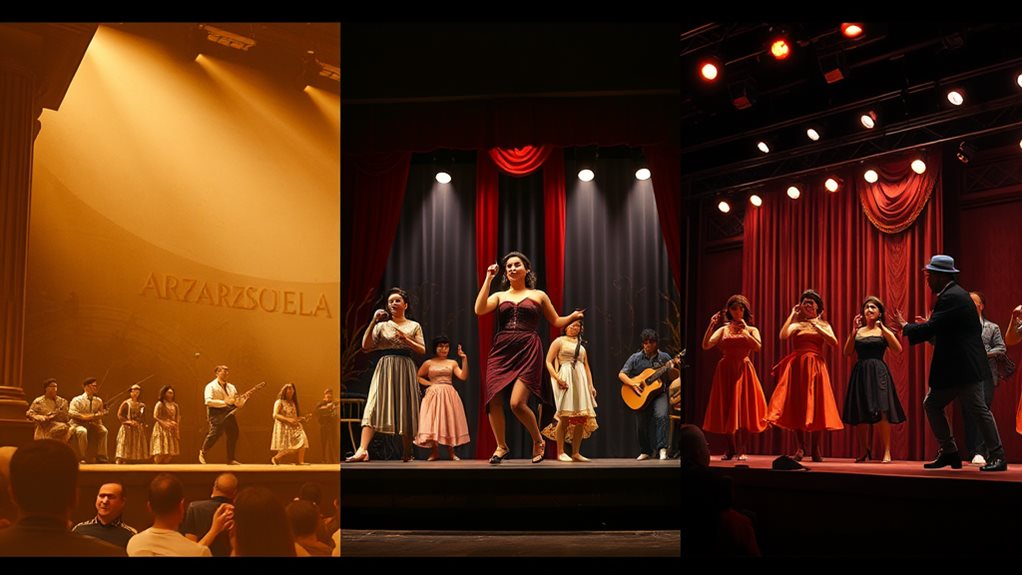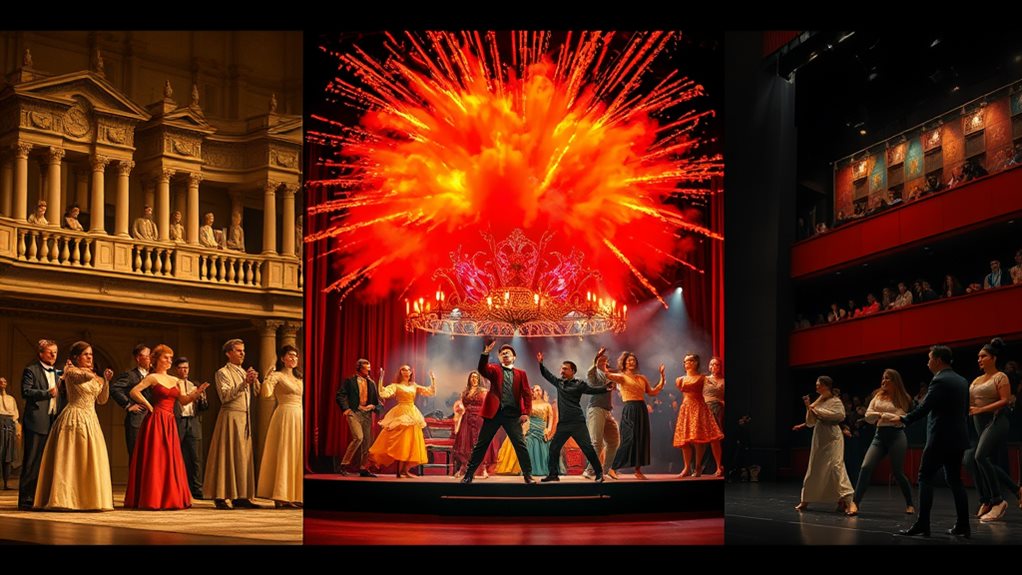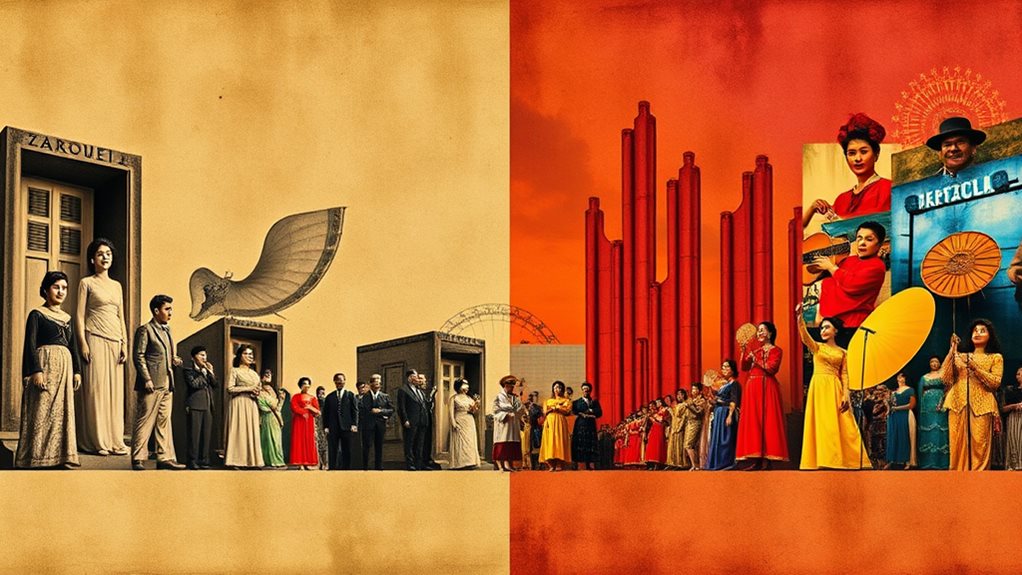The evolution of Filipino musical theater is marked by significant transformations, influenced by various cultural and historical factors.
Filipino musical theater originated from pre-colonial traditions and Spanish-influenced sarswela. The American colonial era introduced Western theatrical forms, but it also imposed censorship that shaped narratives. Despite these restrictions, the period saw the emergence of local storytelling.
Post-war, original Filipino works flourished, showcasing the country's unique experiences. This was evident in the works of notable Filipino composers, such as Leopoldo Yabes and Felipe de Leon, who incorporated traditional folk music into their compositions.
Today, Filipino musical theater is characterized by a vibrant mix of traditional folk music and contemporary genres. This blend of styles reflects the diverse experiences of the Filipino people. The rise of Original Pilipino Music (OPM) and digital platforms has further expanded the reach of Filipino musical theater, allowing it to transcend geographical boundaries.
The future of Filipino musical theater holds exciting potential for international collaboration and the exploration of new narratives. This will enable Filipino artists to engage with global audiences and share their unique perspectives on the world.
Early Influences and Beginnings

The Philippines' Pre-Colonial Theatrical Traditions Evolved with Spanish Influence****
The Philippines' pre-colonial theatrical traditions involved ritualistic mimetic dances and community-based performances. The arrival of the Spanish in 1565 significantly impacted the development of Filipino musical theater. Spanish theater, with its emphasis on religious and secular plays, became a powerful tool for evangelization.
Spanish Theater's Impact on Filipino Culture
Friars utilized these performances to draw natives into the pueblo and promote Catholicism. This resulted in the blending of Spanish theatrical forms with existing Indigenous rituals, creating unique hybrid genres like the *komedya* and *sinakulo*.
These performances became intertwined with town fiestas and Catholic liturgical feasts, showcasing a fascinating synthesis of cultures.
Indigenous Rituals and Secular Plays Coexisted
Alongside these religious works, secular plays also flourished, providing entertainment for the community. Indigenous rituals continued to thrive, showcasing distinct traditions like the *kinabayo*, *palo-palo*, and *sayaw*.
These maintained their separate identities rooted in local customs and beliefs despite the introduction of Spanish theater.
The Emergence of Sarswela in Filipino Musical Theater
The late 19th century witnessed the introduction of the *sarswela*, a form of musical theater that would become incredibly popular. This genre quickly gained prominence, blending music, drama, and dance.
The sarswela showcased Filipino stories and was composed in Tagalog and other local languages, marking a significant stride toward the emergence of a distinctly Filipino musical theater tradition.
American Era and Resistance
The American colonial era significantly impacted Filipino musical theater, shaping its trajectory through both direct influence and indirect resistance. This period began with the recruitment of Filipino performers for American expositions, where they showcased American songs and dances alongside Western theatrical forms like vaudeville.
The Sedition Act of 1901 forced artists to utilize theatrical symbolism and coded messages within their productions. For instance, plays like 'Tanikalang Guinto' and 'Kahapon, Ngayon at Bukas' employed flags, costumes, and character names to subtly critique American occupation. Characters and props symbolically represented the Philippine flag and revolutionary emblems, which were prohibited from public display.
Historical themes, such as the Philippine-American War, became central to narratives, reflecting the complex relationship between both nations. Productions like 'Shoo Fly Regiment' highlighted this dynamic. Other plays addressed labor and social issues within the Filipino community, showcasing the plight of the people under American rule.
Despite facing censorship and repression, Filipino artists ingeniously utilized theatrical symbolism to express their discontent. This period saw a subtle yet potent form of resistance, ultimately demonstrating the enduring power of cultural resilience in the face of colonial dominance**. The use of subtle messaging**, historical themes, and symbolic performances allowed Filipino artists to maintain their national identity while navigating a complex political landscape.
American cultural elements were introduced into the Filipino theatrical landscape during this period. However, the response manifested as a subtle yet potent form of resistance. This resistance ultimately allowed Filipino artists to maintain their cultural identity and express their discontent with American rule.
Post-War Resurgence and Fusion

After World War II, Filipino musical theater experienced a resurgence. The restoration of damaged theaters and the production of both Broadway musicals and original Filipino works marked this resurgence. The Manila Metropolitan Theater's reopening in 1978, after a four-month restoration, highlighted the importance of reviving cultural spaces.
The staging of Broadway musicals by Filipino actors showcased local talent's ability to tackle quintessential American stories. The 1952 performance of "South Pacific" by Filipino actors demonstrated this ability.
Professional theater companies like Repertory Philippines produced both Broadway classics and original works, building a foundation for future generations of Filipino artists. These productions, often held in venues like the PhilamLife Auditorium, helped fuel the growth of musical theater.
The Marcos administration invested significantly in the arts, including the Metropolitan Theater's restoration spearheaded by Imelda Marcos. This cultural restoration initiative spurred the growth of musical theater, despite being born from a specific political context.
However, the decline in government support post-Marcos impacted accessibility. Despite this, theater continued to reflect socio-political realities, especially themes of national identity and independence. The works of Brecht and Boal influenced these themes, showcasing the power of theater to engage with and influence the ongoing national dialogue.
Contemporary Styles and Innovation
The Evolution of Filipino Musical Theater****
The socio-political reflections in Filipino musical theater have continued to evolve, influenced by artists like Brecht and Boal. This evolution has shaped the distinct sounds and styles of contemporary Filipino music. For example, Manila Sound's upbeat disco and Pinoy Rock's Western influences have become popular genres.
Additionally, Pinoy Pop's catchy melodies and Pinoy Jazz's fusion of folk with jazz elements have contributed to the country's diverse musical landscape.
Influence of Western and Indigenous Elements****
Western classical music, jazz, and rock have significantly influenced Filipino musical theater. However, indigenous elements such as the kulintang, gong, and tambol continue to represent traditional sounds.
The cultural impacts of Malay, Chinese, and Islamic influences are also woven into the musical fabric, creating a unique sound. This fusion of styles has been adapted and localized from theatrical forms like zarzuela and bodabil.
The Role of Technology****
The recording industry's arrival popularized Filipino music, while television and radio broadened its reach.
Digital platforms have expanded accessibility, complementing live performances and music festivals. This has enabled a new generation of artists to emerge, building upon the groundwork of their predecessors and showcasing diverse musical styles.
Musical collaborations are increasingly common, further enriching the tapestry of contemporary Filipino music. These collaborations haven't only enriched the soundscape but also created innovative and diverse musical content.
How Have Lesser-Known Filipino Musical Instruments Influenced the Evolution of Filipino Musical Theater?
In recent years, Filipino musical theater has seen a resurgence of traditional sounds, largely influenced by exploring rare and nearly extinct instruments. These unique creations not only enhance the storytelling through their distinct tones but also connect audiences to the rich cultural heritage of the Philippines, deepening the theatrical experience.
Modern OPM and Global Impact

The Evolution of OPM: A Journey to Global Recognition
Original Pilipino Music (OPM) has transformed into a globally recognized genre through a blend of cultural fusion and digital accessibility.
From the Manila Sound of the 70s to its current diverse landscape, OPM's evolution has been fueled by the fusion of traditional Filipino melodies with Western pop influences****. This transformation hasn't only shaped Filipino identity but also resonated internationally.
The rise of digital platforms, such as Spotify and YouTube, has broadened OPM's reach, connecting Filipino artists with global audiences.
For instance, OPM artists like Lea Salonga and apl.de.ap have achieved global recognition, showcasing the genre's versatility and appeal. The accessibility of digital platforms allows for a deeper understanding and appreciation of Filipino culture.
The emotional touchstones of OPM include:
- Nostalgic power: Classic OPM hits can transport listeners back to cherished memories.
- National pride: Hearing a Filipino song on international radio can evoke a sense of pride.
- Energetic performances: Live OPM concerts can unite people through music.
- Discovery of new artists: Finding a new OPM artist can introduce listeners to contemporary sounds and stories.
OPM's continued evolution is marked by embracing new genres and styles while retaining its unique Filipino heart.
This dynamic blending of tradition and innovation ensures its enduring global impact, making it a testament to Filipino creativity and resilience****. The modern OPM scene is a vibrant mixture of cultural influences, and its accessibility through digital platforms ensures its continued growth and reach across geographical boundaries.
Questions and Answers
What Roles Did Women Play in Early Musical Theater?
Women played integral roles in shaping early musical theater. They acted as performers, writers, and composers, influencing the development of diverse forms and content. In the 19th and early 20th centuries, female performers began to break down barriers in the entertainment industry. For example, Olive Gilbert was a notable figure, known for writing and composing her own musicals. Women like Anna Cora Mowatt adapted styles, incorporating various genres and themes into their work. This not only showcased their talents but also contributed to the rich cultural representation in early musical theater.
How Did Censorship Affect Theatrical Productions?
Censorship significantly impacted theatrical productions. It shaped narratives by forcing playwrights to write around sensitive topics or use symbolism to convey their messages. For example, in Lope de Vega's play 'Fuente Ovejuna', the characters' struggles against an oppressive system were veiled in metaphors to avoid censorship.
Censorship limited expression by restricting the discussion of certain topics, such as politics, religion, or social issues. This led to the development of coded language and subtle hints to convey the playwright's intended message.
The effects of censorship had profound cultural implications, as it influenced the way people perceived and engaged with art. In some cases, censorship forced artists to go underground, leading to the emergence of alternative art movements. For instance, the existence of underground theater groups in Eastern Europe during the Cold War allowed artists to express themselves freely, despite the strict censorship laws.
Did Musical Theater Influence Philippine Film?
Musical theater had a significant influence on Philippine film. This influence can be seen in the numerous musical adaptations that were produced, showcasing the country's rich cultural heritage. For example, the iconic Filipino musical "Tinikling" has been adapted into several films, featuring traditional dances and music that are deeply rooted in Philippine culture.
The cultural exchange between musical theater and Philippine film also shaped the aesthetics and narrative styles of films in the country. Many filmmakers drew inspiration from the vibrant colors, elaborate costumes, and dramatic storytelling of musical theater productions. This is evident in films like "Sana Maulit Muli" (1995), which features a blend of drama, romance, and music.
The influence of musical theater on Philippine film is a testament to the country's rich cultural diversity and its ability to absorb and adapt different artistic influences.
What Is the Future of Filipino Musical Theater?
The future of Filipino musical theater is marked by increased audience engagement and diverse cultural representation. This growth is driven by innovative productions that cater to a wider range of audiences.
As a result, we can expect to see more experimental and modern musical productions, such as combining traditional Filipino music with contemporary styles and themes. This fusion of old and new will attract a broader audience and provide a fresh take on classic Filipino stories.
The strengthening of national identity is also a key aspect of Filipino musical theater's future. By showcasing the country's rich cultural heritage, these productions promote a sense of pride and unity among Filipinos. For example, musicals that highlight the Philippines' history, folklore, and traditions will continue to resonate with audiences and inspire a new generation of artists.
How Has Technology Impacted Opm's Reach?
Original Pilipino Music (OPM) has significantly expanded its global reach through digital platforms and social media.
This increased accessibility has led to the growth of international fan bases and collaborations, ultimately impacting both music consumption and creation. For instance, social media platforms such as YouTube, Facebook, and TikTok have allowed Filipino artists to share their music with a broader audience worldwide. The use of these digital platforms has also facilitated international collaborations between Filipino artists and artists from other countries, further increasing OPM's global presence. The rise of digital music streaming platforms like Spotify and Apple Music has also contributed to the growth of OPM's international fan base.